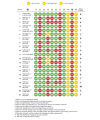The Use of Mobile Assessments for Monitoring Mental Health in Youth: Umbrella Review
- PMID: 37725422
- PMCID: PMC10548333
- DOI: 10.2196/45540
The Use of Mobile Assessments for Monitoring Mental Health in Youth: Umbrella Review
Abstract
Background: Improving mental health in youth is a major concern. Future approaches to monitor and intervene in youth mental health problems should rely on mobile tools that allow for the daily monitoring of mental health both actively (eg, using ecological momentary assessments [EMAs]) and passively (eg, digital phenotyping) by capturing individuals' data.
Objective: This umbrella review aims to (1) report the main characteristics of existing reviews on mental health and young people, including mobile approaches to mental health; (2) describe EMAs and trace data and the mental health conditions investigated; (3) report the main results; and (4) outline promises, limitations, and directions for future research.
Methods: A systematic literature search was carried out in 9 scientific databases (Communication & Mass Media Complete, Psychology and Behavioral Sciences Collection, PsycINFO, CINAHL, ERIC, MEDLINE, the ProQuest Sociology Database, Web of Science, and PubMed) on January 30, 2022, coupled with a hand search and updated in July 2022. We included (systematic) reviews of EMAs and trace data in the context of mental health, with a specific focus on young populations, including children, adolescents, and young adults. The quality of the included reviews was evaluated using the AMSTAR (Assessment of Multiple Systematic Reviews) checklist.
Results: After the screening process, 30 reviews (published between 2016 and 2022) were included in this umbrella review, of which 21 (70%) were systematic reviews and 9 (30%) were narrative reviews. The included systematic reviews focused on symptoms of depression (5/21, 24%); bipolar disorders, schizophrenia, or psychosis (6/21, 29%); general ill-being (5/21, 24%); cognitive abilities (2/21, 9.5%); well-being (1/21, 5%); personality (1/21, 5%); and suicidal thoughts (1/21, 5%). Of the 21 systematic reviews, 15 (71%) summarized studies that used mobile apps for tracing, 2 (10%) summarized studies that used them for intervention, and 4 (19%) summarized studies that used them for both intervention and tracing. Mobile tools used in the systematic reviews were smartphones only (8/21, 38%), smartphones and wearable devices (6/21, 29%), and smartphones with other tools (7/21, 33%). In total, 29% (6/21) of the systematic reviews focused on EMAs, including ecological momentary interventions; 33% (7/21) focused on trace data; and 38% (8/21) focused on both. Narrative reviews mainly focused on the discussion of issues related to digital phenotyping, existing theoretical frameworks used, new opportunities, and practical examples.
Conclusions: EMAs and trace data in the context of mental health assessments and interventions are promising tools. Opportunities (eg, using mobile approaches in low- and middle-income countries, integration of multimodal data, and improving self-efficacy and self-awareness on mental health) and limitations (eg, absence of theoretical frameworks, difficulty in assessing the reliability and effectiveness of such approaches, and need to appropriately assess the quality of the studies) were further discussed.
Trial registration: PROSPERO CRD42022347717; https://www.crd.york.ac.uk/prospero/display_record.php?RecordID=347717.
Keywords: EMAs; digital phenotyping; ecological momentary assessments; mental health; mobile assessment; mobile phone; umbrella review; youth.
©Laura Marciano, Emanuela Vocaj, Mesfin A Bekalu, Antonino La Tona, Giulia Rocchi, Kasisomayajula Viswanath. Originally published in the Journal of Medical Internet Research (https://www.jmir.org), 19.09.2023.
Conflict of interest statement
Conflicts of Interest: None declared.
Figures



References
-
- World mental health report: transforming mental health for all. World Health Organization. 2022. Jun 16, [2023-08-23]. https://www.who.int/publications/i/item/9789240049338 .
-
- Rathod S, Pinninti N, Irfan M, Gorczynski P, Rathod P, Gega L, Naeem F. Mental health service provision in low- and middle-income countries. Health Serv Insights. 2017 Mar 28;10:1178632917694350. doi: 10.1177/1178632917694350. https://journals.sagepub.com/doi/10.1177/1178632917694350?url_ver=Z39.88... 10.1177_1178632917694350 - DOI - DOI - PMC - PubMed
-
- The national institute of mental health strategic plan. National Institute of Mental Health. [2023-08-23]. https://www.nimh.nih.gov/about/strategic-planning-reports .
-
- Mental illness. National Institute of Mental Health. [2022-08-28]. https://www.nimh.nih.gov/health/statistics/mental-illness .
-
- Patel V, Saxena S, Lund C, Thornicroft G, Baingana F, Bolton P, Chisholm D, Collins PY, Cooper JL, Eaton J, Herrman H, Herzallah MM, Huang Y, Jordans MJ, Kleinman A, Medina-Mora ME, Morgan E, Niaz U, Omigbodun O, Prince M, Rahman A, Saraceno B, Sarkar BK, De Silva M, Singh I, Stein DJ, Sunkel C, UnÜtzer J. The Lancet Commission on global mental health and sustainable development. Lancet. 2018 Oct 27;392(10157):1553–98. doi: 10.1016/S0140-6736(18)31612-X.S0140-6736(18)31612-X - DOI - PubMed

